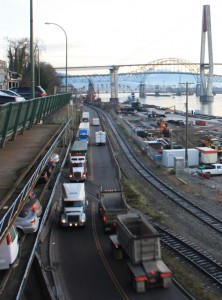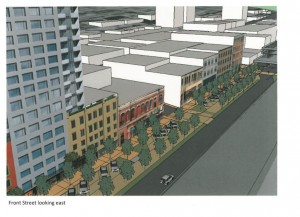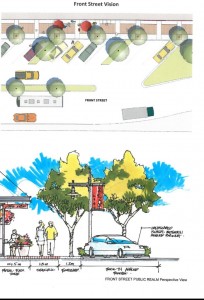The City’s official jump onto the Let’s-Make-Front-Street-Livable bandwagon has received a little media play locally. It has also caused some rumbling in local blogosphere. Much like the UBE debate last year, there is a lot of miscommunication. There is one point I want to clarify when it comes to my vision for the waterfront.
As much as I support the City’s new vision for Front Street, there are aspects I am more reluctant to support. I think the entire Parkade has to go, not just the more decrepit half. I think we need to reassess how more 30-story buildings with 5-story pedestals fit on our waterfront. I think we need to connect our waterfront east to Quayside and west to Sapperton. Most significantly, I don’t think it is necessary, or even desirable, to force trucks off of Front Street.
This is not a new position, but something I have been saying all along. Some local comments have suggested I “hate trucks” and want to move everyone back to “horses and buggies”. Anyone who knows me well knows that I really, really hate horses. So that argument is spurious.
When considering a future for Front Street, we need to deal with what we have and make the best of it. We have three sets of rails that are not going anywhere soon, so this is never going to be a completely re-claimed area. The main impacts from trucks and trains are noise and soot, both of which will be significantly improved with the removal of the Parkade.* With the loss of the parkade pedestals, there will be lots of room for two lanes of through-traffic, and some combination of back-in angle or parallel parking with wide sidewalks, trees and greenery to provide a buffer from the exhaust stacks of trucks and trains. It will still have a bit of an “industrial” feel, much like the Warehouse District of Yaletown, but with the river as a view and a provider of breeze. It will be a livable, commercially viable space. It could even become a regional evening entertainment district if connected smartly to the Plaza 88 Theatre complex and Skytrain stations.
With a 30km/h speed limit, there is no reason trucks can’t continue to use Front Street, as long as we keep the pavement in good repair (to reduce noise) and integrate green buffers. New Westminster’s waterfront has historically been a working one, and the design of the new park reflects that. I suspect development of Front Street could continue that trend, and connect seamlessly. Anyone who has been to the Quays of Old Montreal knows what I am talking about. Rails, trucks, commercial property, and livable space; intelligently planned to work together.

The other way to look at the problem is what happens if we close Front Street to Traffic? Some have suggested pushing the trucks to Royal Avenue or 8th Ave. Evidently, these people do not live on Royal Avenue or 8th Ave. Royal already has difficulty with it’s truck traffic, especially around the big hill between 8th Street and Stewardson. The hill is steep, with a light-controlled intersection at the top, and half-way down. Between laden trucks grumbling to get started on a steep slope going up the hill to truckers using Jake Brakes to go down the hill and the inevitable rattle-and-crack of containers over the necessarily-uneven pavement at the mid-hill intersection, the large number of residents on Royal have enough truck problems of their own. 8th Ave also has it’s own traffic problems, and connects poorly at either end. It is worth noting both Royal Ave and 8th Ave are the locations of two major school-building projects. Generally, truck routes and school zones don’t mix.
So, no. Removing trucks from Front Street probably creates more problems than it solves. However, that doesn’t mean we need to build a 4-lane high-speed truck route to, as people euphemistically say, “keep traffic moving”. Nothing we do on Front Street will solve the problems of congestion at the Queensborough Bridge interchange, on Stewardson and Third Ave, Front and Columbia, Columbia and Brunette or the Brunette and Highway 1 interchange. The last 50 years or study on traffic demand management around the world has shown one thing: if you replace two congested lanes of traffic with four lanes, the only long-term result is four congested lanes.
Keep Front Street at two lanes, keep trucks on it, to reduce the load on other routes, but don’t let the presence of a few trucks take away from a larger vision for a useable and commercially viable Front Street.
* I note if Larco builds a 30-story development on a 5-story parking pedestal, a la Plaza 88 and Carnarvon Canyon, we are into a whole new level of negative impact traffic noise and pollution wise – but that’s another post for another day.





